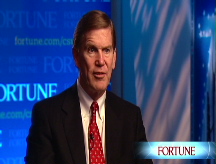Oil prices jump more than $6
Stocks rebounded as interbank lending appeared to loosen up, coaxing investors back to oil.
NEW YORK (CNNMoney.com) -- Oil prices rose above $70 a barrel Tuesday, propelled by a slipping dollar, a stronger equities market and OPEC production cuts, as Americans went to the polls.
U.S. crude for December delivery ended the day $6.62 higher to $70.53 a barrel in New York, but not before spiking to $71.77 as thawing credit boosted stocks and eased crude investors' worries about market risk.
The equities market rebounded, sending the Dow up by as much as 300 points, as interbank lending loosened, allowing more cash to flow through the system.
"If we continue to see improvements in the credit markets, we could see oil stabilize or gain more ground," said Rachel Ziemba, energy analyst at economic research firm RGE Monitor.
Credit and rate cuts: The London interbank lending rate (Libor), a measurement of how much banks charge to lend money to each other, has been on the decline thanks to efforts by the world's governments and central banks.
The Federal Reserve cut its key lending rate last Wednesday to 1%, a low not seen since 2003. The Bank of Japan followed on Friday, cutting rates for the first time in 7 years.
The 3-month Libor rate had fallen to 2.71% from 2.86% on Monday. The lower the rate, the cheaper it is for banks to borrow cash, and the more dollars are available to the market.
Additionally, the Bank of England and the European Central Bank are expected to cut rates on Thursday, according to Ziemba.
Stocks: Stock markets rallied Tuesday on anticipation of rate cuts from Europe's central banks, and after several major companies reported better than expected earnings.
Credit card giant MasterCard (MA) reported stronger than expected earnings, not including a massive legal settlement with rival Discover Financial Services (DFS), which analysts discount when trying to determine the health of the company.
Meanwhile Illinois-based food producer Archer Daniels Midland Co. said its quarterly profit more than doubled as selling prices rose.
Markets have also been buoyed by the fact that, over the past several weeks, the financial markets have not seen any of the large bank blowups that have characterized the economic crisis since Bear Stearns crumbled in March.
"You're not getting that big heavy body blow to the market," said Tom Orr, head of research for investment brokerage Weeden & Co.
Potential collapses of global financial institutions such as UBS (UBS) and Barclays (BCS) have been averted by influxes of foreign cash, or by government action.
Stock market advances point out a "willingness by investors to take on more risk," said Ziemba.
However the bump may only be temporary, she added, since the global economy is still slow.
Over the past several months, worry about a stagnating global economy, and the corresponding decline in fuel demand, helped drive oil prices down from a record high of $147.27 a barrel in July.
Dollar: A slipping dollar also helped support crude prices.
The U.S. dollar fell compared to the 15-nation euro as investors sought the more lucrative returns of stocks and commodities. Investors often buy the dollar as a safe investment to avoid risk in other markets.
Oil, like most commodities, is traded in U.S. dollars. So when the value of the dollar falls, oil becomes more affordable to non-U.S. investors, and its dollar-denominated price goes up.
OPEC cuts: Also pushing oil higher were reports that members of the Organization of Petroleum Exporting Countries had begun implementing the cartel's planned production cuts.
Saudi Arabia cut exports by 900,000 barrels per day, according to media reports. Iran also said it was committed to cutting 199,000 barrels a day, according to reports.
While OPEC pledged in October to cut production by a total of 1.5 million barrels a day, there was real concern among investors about whether or not members would comply with the guideline, according to Ziemba.
The production cuts, along with strength in the equities markets have led many commodity investors to re-examine oil's supply and demand picture, according to Orr.
"People are starting to look a little more rationally about where commodity prices should be," said Orr.
However concerns remain that cuts may not be enough to give oil a bottom.
"Despite the production cuts, we're still in a global recession, and that's bad for oil demand," said Ziemba.
U.S. demand: A report on U.S. crude supplies from the Energy Department, a key measurement of demand for the week, is expected to show a 500,000 barrel increase for last week, according to research firm Platts.
An increase in crude supplies sometimes indicates that refineries won't need to purchase as much oil over the next week to meet production goals.
"There's no rush to go out and buy oil," said Orr. It may take between 5 and 8 weeks before OPEC's supply reduction begins to have an impact, he added.
Platts also predicted refineries were operating at 85.5% of capacity last week, which is abnormally low.
The low refinery levels could be due to maintenance issues, repairs resulting from the summer hurricane season, as well as lack of demand, according to Orr.
A report of gas station credit card swipes from MasterCard showed that demand for gasoline was down 3.9% from last year for the week ended Oct. 31.
Gas demand increased by 1.3% compared to the week before, but it was the 28th straight week in which the report showed a decline in fuel demand from the prior year. ![]()





